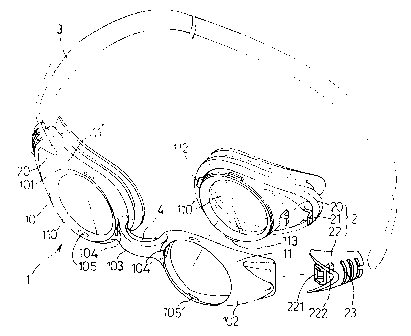Some of the information on this Web page has been provided by external sources. The Government of Canada is not responsible for the accuracy, reliability or currency of the information supplied by external sources. Users wishing to rely upon this information should consult directly with the source of the information. Content provided by external sources is not subject to official languages, privacy and accessibility requirements.
Any discrepancies in the text and image of the Claims and Abstract are due to differing posting times. Text of the Claims and Abstract are posted:
| (12) Patent: | (11) CA 2314593 |
|---|---|
| (54) English Title: | SWIMMING GOGGLES |
| (54) French Title: | LUNETTES DE NAGE |
| Status: | Expired and beyond the Period of Reversal |
| (51) International Patent Classification (IPC): |
|
|---|---|
| (72) Inventors : |
|
| (73) Owners : |
|
| (71) Applicants : |
|
| (74) Agent: | OYEN WIGGS GREEN & MUTALA LLP |
| (74) Associate agent: | |
| (45) Issued: | 2004-02-10 |
| (22) Filed Date: | 2000-07-26 |
| (41) Open to Public Inspection: | 2001-07-10 |
| Examination requested: | 2000-07-26 |
| Availability of licence: | N/A |
| Dedicated to the Public: | N/A |
| (25) Language of filing: | English |
| Patent Cooperation Treaty (PCT): | No |
|---|
| (30) Application Priority Data: | ||||||
|---|---|---|---|---|---|---|
|
The invention provides a new type of swimming goggles, characterized in that:
a binding frame is used for assembling the main lens frames. The binding frame
includes left and right frame units and a nose bridge that combines the left
and right
frame units. On the left and right frame units near the nose bridge is at
least one clasp
unit. On the main frame unit corresponding to the clasp unit is a clasp piece.
On one
side of the left and right frame units away from the nose bridge is an
assembling
device, thus with the coordinative assembly of the clasp unit, clasp piece and
the
assembling device, the main frame unit can be securely fastened onto the
binding
frame.
Note: Claims are shown in the official language in which they were submitted.
Note: Descriptions are shown in the official language in which they were submitted.

2024-08-01:As part of the Next Generation Patents (NGP) transition, the Canadian Patents Database (CPD) now contains a more detailed Event History, which replicates the Event Log of our new back-office solution.
Please note that "Inactive:" events refers to events no longer in use in our new back-office solution.
For a clearer understanding of the status of the application/patent presented on this page, the site Disclaimer , as well as the definitions for Patent , Event History , Maintenance Fee and Payment History should be consulted.
| Description | Date |
|---|---|
| Time Limit for Reversal Expired | 2010-07-26 |
| Letter Sent | 2009-07-27 |
| Small Entity Declaration Determined Compliant | 2007-07-18 |
| Inactive: IPC from MCD | 2006-03-12 |
| Grant by Issuance | 2004-02-10 |
| Inactive: Cover page published | 2004-02-09 |
| Pre-grant | 2003-11-26 |
| Inactive: Final fee received | 2003-11-26 |
| Notice of Allowance is Issued | 2003-08-14 |
| Notice of Allowance is Issued | 2003-08-14 |
| Letter Sent | 2003-08-14 |
| Inactive: Approved for allowance (AFA) | 2003-06-25 |
| Amendment Received - Voluntary Amendment | 2002-11-13 |
| Inactive: S.30(2) Rules - Examiner requisition | 2002-07-25 |
| Inactive: Cover page published | 2001-07-13 |
| Application Published (Open to Public Inspection) | 2001-07-10 |
| Inactive: First IPC assigned | 2000-10-13 |
| Filing Requirements Determined Compliant | 2000-08-23 |
| Inactive: Filing certificate - RFE (English) | 2000-08-23 |
| Application Received - Regular National | 2000-08-22 |
| All Requirements for Examination Determined Compliant | 2000-07-26 |
| Request for Examination Requirements Determined Compliant | 2000-07-26 |
There is no abandonment history.
The last payment was received on 2003-07-16
Note : If the full payment has not been received on or before the date indicated, a further fee may be required which may be one of the following
Please refer to the CIPO Patent Fees web page to see all current fee amounts.
| Fee Type | Anniversary Year | Due Date | Paid Date |
|---|---|---|---|
| Application fee - small | 2000-07-26 | ||
| Request for examination - small | 2000-07-26 | ||
| MF (application, 2nd anniv.) - small | 02 | 2002-07-26 | 2002-07-12 |
| MF (application, 3rd anniv.) - small | 03 | 2003-07-28 | 2003-07-16 |
| Final fee - small | 2003-11-26 | ||
| MF (patent, 4th anniv.) - small | 2004-07-26 | 2004-06-30 | |
| MF (patent, 5th anniv.) - small | 2005-07-26 | 2005-06-29 | |
| MF (patent, 6th anniv.) - small | 2006-07-26 | 2006-06-21 | |
| MF (patent, 7th anniv.) - small | 2007-07-26 | 2007-07-18 | |
| MF (patent, 8th anniv.) - small | 2008-07-28 | 2008-07-07 |
Note: Records showing the ownership history in alphabetical order.
| Current Owners on Record |
|---|
| HERMAN CHIANG |
| Past Owners on Record |
|---|
| None |